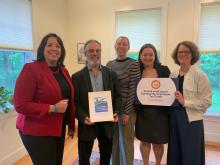Considerations for Equitable Reopening
Artwork: “Essential: Student, Worker, and Parent” by Nicole Garcia
“Essential: Student, Worker, and Parent” depicts a student, nurse, and parent struggling with the effects of the pandemic. Students during the pandemic have had to deal with learning in a new remote environment, but also teaching themselves in under resourced homes. Many students are first generation Americans causing language barriers between their parents and school. Let alone students who may not be in a safe household, learning has become difficult. Medical workers are given a great responsibility with stress and heavy loads to carry. Patients in dying need and become emotional support for their families. They risk their lives to save others and risk the families they come home to as well. Parents who lost their jobs along with a source of income for their families are scrambling to provide, leaving some parents feeling like failures due to not being able to provide enough.
Nicole Garcia's art is published through the Punto Urban Art Museum, a program of North Shore CDC. Learn more about the museum's programs and their "Free COVID Resources."
Massachusetts CDCs, like so many others, are eager to return to “business as usual” in light of eased COVID-19-related restrictions while at the same time fully committed to keep infections low and people safe. Massachusetts CDCs are rooted in the communities in which they work and therefore recognize the importance – literally and symbolically – of re-opening their physical doors. As of mid-July, over half of CDCs who responded to a survey had at least partially reopened their offices. All but two CDCs surveyed indicated that they would be open in some capacity by mid-September.
As CDCs bring staff back to their offices, they are considering how to do so in a way that considers – and does not enhance – the disparate impacts of the COVID-19 crisis. Over the last several months, we have seen how COVID-19 and the concurrent economic crisis has disproportionately affected low-income, and Black and Latinx communities. In addition to disproportionate impact by race and ethnicity, COVID has affected many demographic groups in proportionally different ways: parents and other caregivers have had to respond to school closings in a way that others have not, individuals with pre-existing health conditions have had to take even more precautions to stay healthy than their healthier counterparts, etc. As CDCs and other offices begin to re-open, they are thinking about how to reopen in an equitable way that treats all members of their staff fairly.
One CDC Executive Director that we spoke with told us that decisions around reopening can have racial implications, this ED acknowledged that one factor that was considered when creating their reopening plan was the racial makeup of the staff structure. The ED found that the staff who could more easily continue to work remotely vs the staff that had a greater reliance on in-person contact to do their work often exposed potential disparate effects across racial lines.
Another issue that CDCs must consider is how the commute to work affects risk and how different commuting patterns correlate with demographic factors. Crowded busses and trains carry more risk for disease transmission than private vehicles. While CDC employees in smaller towns and rural areas may regularly drive to work, CDCs in Boston, Worcester, and Springfield must consider how employees who rely on public transportation will get to work. Further, Black and Latinx workers are more likely to commute to work via public transportation as compared with their white counterparts, putting them at increased risk for disease. In reopening offices, urban employers could consider arranging for increased parking or reimbursement of parking costs to encourage private transportation. In his Reopening Massachusetts Report, Governor Baker urges employers to consider staggering hours to allow employees to avoid popular commute times.
Employers and Employees need to work together to determine ways in which work can be completed productively and safely and should continually apply an equity lens to decisions around reopening. One way employers can achieve this is through a hybrid model: in addition to the 70% of CDCs that said that they were open to staff on a limited basis, close to 40% of members indicated that they plan to have a mix of online and in-person programs in fall. As CDCs consider reopening their offices and holding in-person programs, they could also consider:
- Working with employees who are parents and guardians on ways they can continue to be productive while ensuring their children are cared for. Among other considerations, this could include offering a flexible work schedule for these employees as well as a stipend to buy necessary home office supplies and equipment.
- Maximizing safety for older employees or employees with pre-existing conditions or who live with others who are older or have pre-existing conditions, while developing a system to ensure sensitivity to employee privacy.
- Considering ways that disparities in income and wealth might affect employees differently, e.g., it will be harder for an employee with a lower income or less wealth to cut their hours or pay for a new childcare or transportation arrangement than for a wealthier or higher income counterpart.
- Thinking about how office set-up affects employees differently (e.g., lower-level employees are less likely to have their own offices, making social distancing more difficult).
- Investing in technology that allows employees to be as productive as possible when working remotely.
- Considering the role that the organization plays in the community – how to provide maximum benefit to community members while protecting their health and safety.
COVID-19 has exacerbated challenges that existed long before the pandemic. Let’s commit to an equitable re-opening that does not further exacerbate these challenges.









